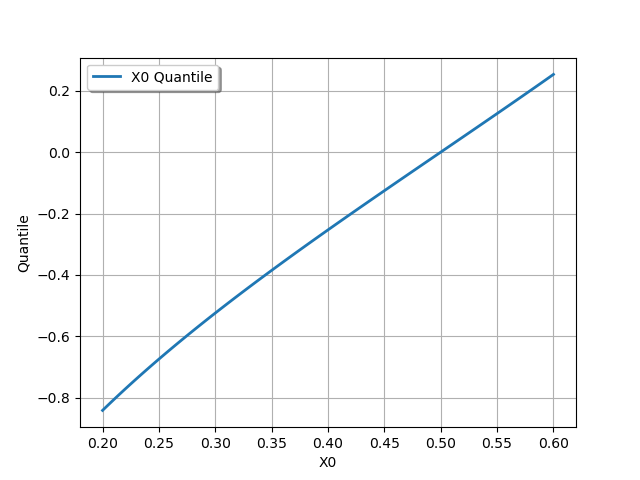Note
Go to the end to download the full example code.
Distribution manipulation¶
In this example we are going to exhibit some of the services exposed by the distribution objects:
ask for the dimension, with the method getDimension ;
extract the marginal distributions, with the method getMarginal ;
to ask for some properties, with isContinuous, isDiscrete, isElliptical ;
to get the copula, with the method getCopula ;
to ask for some properties on the copula, with the methods hasIndependentCopula, hasEllipticalCopula ;
to evaluate some moments, with getMean, getStandardDeviation, getCovariance, getSkewness, getKurtosis ;
to evaluate the roughness, with the method getRoughness ;
to get one realization or simultaneously
realizations, with the method getRealization, getSample ;
to evaluate the probability content of a given interval, with the method computeProbability ;
to evaluate a quantile or a complementary quantile, with the method computeQuantile ;
to evaluate the characteristic function of the distribution ;
to evaluate the derivative of the CDF or PDF ;
to draw some curves.
import openturns as ot
import openturns.viewer as viewer
from matplotlib import pylab as plt
ot.Log.Show(ot.Log.NONE)
Create an 1-d distribution
dist_1 = ot.Normal()
# Create a 2-d distribution
dist_2 = ot.JointDistribution(
[ot.Normal(), ot.Triangular(0.0, 2.0, 3.0)], ot.ClaytonCopula(2.3)
)
# Create a 3-d distribution
copula_dim3 = ot.Student(5.0, 3).getCopula()
dist_3 = ot.JointDistribution(
[ot.Normal(), ot.Triangular(0.0, 2.0, 3.0), ot.Exponential(0.2)], copula_dim3
)
Get the dimension fo the distribution
dist_2.getDimension()
2
Get the 2nd marginal
dist_2.getMarginal(1)
Get a 2-d marginal
dist_3.getMarginal([0, 1]).getDimension()
2
Ask some properties of the distribution
dist_1.isContinuous(), dist_1.isDiscrete(), dist_1.isElliptical()
(True, False, True)
Get the copula
copula = dist_2.getCopula()
Ask some properties on the copula
dist_2.hasIndependentCopula(), dist_2.hasEllipticalCopula()
(False, False)
Get the mean vector of the distribution
dist_2.getMean()
Get the standard deviation vector of the distribution
dist_2.getStandardDeviation()
Get the covariance matrix of the distribution
dist_2.getCovariance()
Get the skewness vector of the distribution
dist_2.getSkewness()
Get the kurtosis vector of the distribution
dist_2.getKurtosis()
Get the roughness of the distribution
dist_1.getRoughness()
0.28209479177387814
Get one realization
dist_2.getRealization()
Get several realizations
dist_2.getSample(5)
Evaluate the PDF at the mean point
dist_2.computePDF(dist_2.getMean())
0.3528005531670077
Evaluate the CDF at the mean point
dist_2.computeCDF(dist_2.getMean())
0.3706626446357781
Evaluate the complementary CDF
dist_2.computeComplementaryCDF(dist_2.getMean())
0.6293373553642219
Evaluate the survival function at the mean point
dist_2.computeSurvivalFunction(dist_2.getMean())
0.40769968167281506
Evaluate the PDF on a sample
dist_2.computePDF(dist_2.getSample(5))
Evaluate the CDF on a sample
dist_2.computeCDF(dist_2.getSample(5))
Evaluate the probability content of an 1-d interval
interval = ot.Interval(-2.0, 3.0)
dist_1.computeProbability(interval)
0.9758999700201907
Evaluate the probability content of a 2-d interval
interval = ot.Interval([0.4, -1], [3.4, 2])
dist_2.computeProbability(interval)
0.129833882783416
Evaluate the quantile of order p=90%
dist_2.computeQuantile(0.90)
and the quantile of order 1-p
dist_2.computeQuantile(0.90, True)
Evaluate the quantiles of order p et q For example, the quantile 90% and 95%
dist_1.computeQuantile([0.90, 0.95])
and the quantile of order 1-p and 1-q
dist_1.computeQuantile([0.90, 0.95], True)
Evaluate the characteristic function of the distribution (only 1-d)
dist_1.computeCharacteristicFunction(dist_1.getMean()[0])
(1+0j)
Evaluate the derivatives of the PDF with respect to the parameters at mean
dist_2.computePDFGradient(dist_2.getMean())
Evaluate the derivatives of the CDF with respect to the parameters at mean
dist_2.computeCDFGradient(dist_2.getMean())
Draw PDF
graph = dist_1.drawPDF()
view = viewer.View(graph)

Draw CDF
graph = dist_1.drawCDF()
view = viewer.View(graph)

Draw an 1-d quantile curve
# Define the range and the number of points
qMin = 0.2
qMax = 0.6
nbrPoints = 101
quantileGraph = dist_1.drawQuantile(qMin, qMax, nbrPoints)
view = viewer.View(quantileGraph)

Draw a 2-d quantile curve
# Define the range and the number of points
qMin = 0.3
qMax = 0.9
nbrPoints = 101
quantileGraph = dist_2.drawQuantile(qMin, qMax, nbrPoints)
view = viewer.View(quantileGraph)
plt.show()
![[X0,X1] Quantile](../../_images/sphx_glr_plot_distribution_manipulation_004.png)
 OpenTURNS
OpenTURNS